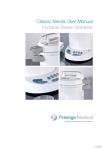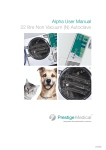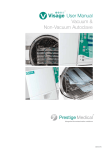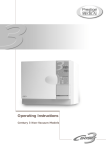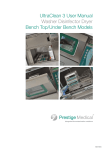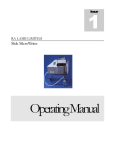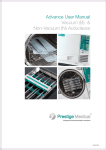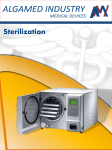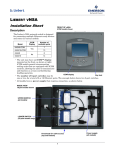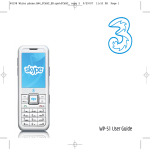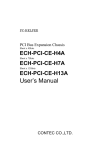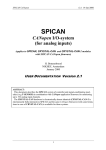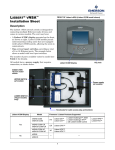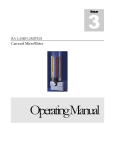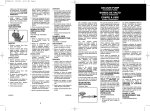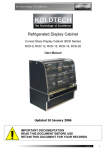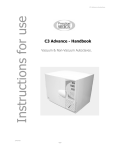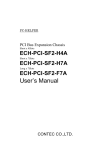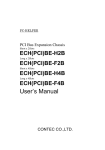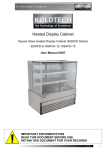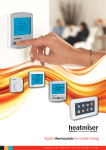Download The appliance for science
Transcript
The appliance for science The Classic Media autoclave - for a safer school laboratory Does your school laboratory need to sterilize liquids and media or eliminate the risk of cross infection through contaminated waste? The Classic Media autoclave offers a professional, safe and affordable solution. Do you need to sterilize liquids and media? Do you currently use a standard pressure cooker for sterilization? Do you use a naked flame as the heat source? If you answer yes to any of these, then the Classic Media with safety interlock lid is the solution. lab ty safe k chec The capacity to surprise The Classic Media is priced to appeal to schools’ budgets. Available in two sizes, it is ideal for a variety of laboratory processes. The Classic Media will fit neatly on a work-bench, is easy to operate and is powered by a standard 13amp/240 volt power supply. Sterilization could not be safer or easier. the science the facts the figures If your school uses a domestic pressure cooker for sterilization then this can represent a serious risk if used incorrectly. they have no temperature or time controls which could result in ineffective sterilization risk of boiling dry if left unattended if placed on a tripod or heated over a Bunsen burner, they can be unstable and are therefore vulnerable to being knocked over without the benefit of a safety locking mechanism, they can be opened prematurely whilst the temperature inside is still high enough for thermal shock to cause glass vessels to explode The Classic Media removes these risks, ensuring that you protect your staff and pupils from the risk of injury and also guarantees sterilization. Safety as standard The Classic Media has a built-in safety mechanism that prevents the unit being opened until the temperature inside has fallen to a safer level. This is important as many hazards occur during the unloading process: Prevention Eliminates the risk of super-heated vessels exploding Interlock safety mechanism Ensures expensive glassware is protected during the controlled cooling process which means liquids won’t leak out Prevents the escape of gas or vapour Removes the potential of accidental overbalance whilst sterilizing. Easy to use controls Fully Automatic - ‘Set & forget’ Load your equipment into one of the special baskets, set the programme with the one-touch button and you can relax with no need for constant supervision giving you more productive time in the laboratory. Reliable Special in-built software ensures exact temperatures are reached for the correct duration, every time. Guarantees 2 year unlimited parts warranty Available in two sizes Choose from our 9 or 12 litre capacity models to meet your sterilization requirements and volumes. Classic Media Interlock 9 litres Classic Media Interlock 12 litres 210047 210048 Max width - overall 340mm 340mm Max height - overall 335mm 420mm Max net weight 3.8kg 4.3kg Chamber diameter 210mm 210mm Chamber height 228mm 318mm Chamber capacity 9 litres 12 litres Max instrument length 200mm 290mm Max load weight (unwrapped) 4kg 3kg Sterilizing temperature 121°C 121°C Min sterilizing time 22 minutes 22 minutes Operating pressure 1.05 bar 1.05 bar Voltage 230v 230v Wattage 1500w 1500w Frequency 50-60Hz 50-60Hz For more information call: 01254 844 103 email: [email protected] web: www.prestigemedical.co.uk 10 year warranty on pressure chamber Lifetime warranty on heating element Fully CE marked to the Medical Devices Directive 93/42/EC. Supplied with basket East House, Duttons Way, Shadsworth Business Park, Blackburn BB1 2QR Classic Media User Manual Portable Steam Sterilizer 211846B 3 Section 1: Introduction Thank you for choosing the Prestige Medical 210047/210048 Classic Media Autoclave, designed to sterilize culture media. After removing from the box, please check for any transit damage. If any damage to the unit is found, please contact your supplier immediately. Together with this unit and operating manual, you will find the following: • Electrical mains cord • Instrument furniture • Spare fuses x2 (when fitted) • Performance test certificate • Certificate of Compliance (230v models only) • Warranty registration card Section 2: Operating symbols, displays and controls The following descriptions refer to the pictures of the controls, display lights and operating symbols opposite. A D Controls: A Depressurization Valve B Start Cycle Button C Pressure Rise Indicator D Interlock Mechanism Display lights: L1Power “On” light illuminates GREEN L2Heating light illuminates ORANGE L3Sterilizing light illuminates YELLOW L4Sterilizing complete light illuminates GREEN L5Fault light illuminates RED C Figures: F1Lid aligned with body, turn clockwise to close F2Lid in closed position Warning symbols: W1 Caution, electric shock hazard W2 Warning, read manual before using the autoclave W3 Warning, unit must be earthed/grounded W4 Warning, heat hazard L2 L3 WARNING! Do not touch the body or lid as these parts become hot when the autoclave is in operation. B L4 L5 W1 W2 W3 W4 L1 F1 F2 211846B 4 Section 3: Operation Before using the autoclave for the first time please take time to read the following pages to familiarise yourself with the operation of the unit. We strongly recommend that all users of the autoclave are trained in its operation. The autoclave is very easy to use. By following this simple operating sequence in conjunction with the pictures of the autoclave, its controls, display panel and operating symbols (page 3), you will be able to ensure your autoclave functions correctly every time. WARNING! The mains outlet MUST BE EARTHED (GROUNDED). The mains plug should always be easily accessible as it is to be relied upon as “the means of disconnection”. 3.7 Starting Press the cycle start button (B) to start the sterilizing cycle. Light: L2 illuminates ORANGE and may flash. As the temperature rises, air will be displaced by steam through the Air Bleed Device located in the lid, until it closes with an audible “click”, sealing the unit. Sterilizing temperature is reached when: Light: L3 illuminates ORANGE L2 flashes ORANGE The sterilizing cycle is completed when: The internal buzzer sounds and Light: L4 is illuminated GREEN. 3.8 Depressurizing 3.1 Connection Attach the cable supplied to the rear of the unit and plug into an EARTHED mains electrical socket of the CORRECT voltage. 3.2 Water Fill the unit to the water level line on the inside of the chamber with 0.75 litres of distilled or de-ionised water. DO NOT USE TAP WATER OR OVERFILL. 3.3 Loading (Media) Place media containers into the instrument basket, and place in the unit. 3.4 Closing Always place the lid on the autoclave with the Depressurization Valve (A) in the open position. Align the black arrows on the lid and body (F1) and with the interlock button (D) pressed down turn in a clockwise direction ensuring it is completely closed (F2). Release the interlock button. Close the Depressurization Valve (A). 3.5 Power on Switch the unit on at the mains. Light: L1 illuminates GREEN 3.6 Temperature The 121ºC temperature is automatically selected when the power is turned on. 211846B Once sterilizing has finished the unit should be left to automatically cool down without opening the pressure release valve. 3.9 Unlocking Once the temperature has reached a safe level and is below 80ºC the interlock will release and the lid can be unlocked. Remove the lid by pressing down on the interlock button (D) and turning the lid in an anti-clockwise direction, aligning the handles (F1 & F2). 3.10 Unloading Lift off the lid, gently place upside down on a solid work surface and leave to cool. Ensure the Depressurization Valve (A) is in the closed position to avoid damaging it. The basket containing the sterilized media can now be lifted out of the unit with care. Allow 5 minutes for the lid to cool down before replacing as per Step “3.4”. DO NOT USE THE MEDIA IF A COMPLETE STERILIZATION CYCLE HAS NOT BEEN ACHIEVED. 5 Section 4: Do’s and Dont’s To ensure your autoclave gives you the years of service for which it was designed, it is important to remember a few “do’s” and “don’t’s” with regards to the operation of the unit and to carry out simple care and maintenance procedures on a weekly basis. 12...reach over the unit when removing cover, to do so may cause burns from rising heat and steam. 13...cover lid or obstruct steam venting area when manually depressurizing. Do ensure that.... * These operations should only be undertaken by a qualified person. 1…you read these instructions and always follow the operating sequence. Care and maintenance 2…the media will withstand the sterilizing temperature selected, bottles are not sealed and screw tops are loose - do not overload the autoclave. 1. Remove from inside the lid and clean with warm, soapy water. 3…the water level is maintained regularly with clean distilled or de-ionised water only. 4…the unit is in a “draft free” environment and is positioned not less than 250mm from adjacent walls. 5…you only use green sealing gasket (219500) and that it is changed at the end of its life, if visibly damaged, or when shrinkage has occurred. 6…the lid is securely closed when the unit is not in use, to avoid the risk of accidental damage. Never leave in position (F1). 7…you quote your model details, serial number and date of purchase when contacting Prestige Medical or your supplier. Do not.... 1…lose this operating instruction manual. 2…add any chemicals whatsoever to the water. 3…attempt to sterilize volatile substances, toxic materials or inappropriate loads. 4…place the unit on heat sensitive surfaces ie polished wood or glass. Green sealing gasket 2. Rinse thoroughly, shake dry, do not wipe. 3. Replace in the lid by tucking evenly under all lugs. It may appear slightly wrinkled until used. 4. Replace when it begins to show signs of leakage. Autoclave 1. If a new gasket leaks, or a persistent leak develops, gently clean the sealing surface of both the lid and body of the unit with a “Scotchbrite” scrubbing pad making sure you do not remove any metal. Rinse both surfaces but do not dry. 2. Clean both interior and exterior with warm, soapy water ensuring the electrical parts are kept dry. 3. Monitor the first cycle of the day to check the Air Bleed Device, which is located inside the lid, audibly “clicks” shut. 4. Prestige Medical recommends that your unit is calibrated at six monthly intervals. 5. Lubricate underside of body lugs with “vaseline” if the lid becomes stiff. DO NOT LUBRICATE GASKET 5…open the Depressurization Valve (A) during the sterilization cycle. 6…leave the Depressurization Valve (A) in the “open” position when placing the lid upside down on a work surface. 7…immerse the unit or electrical cord in water when cleaning. 8…use abrasive materials or lubricants when cleaning. 9…drop or abuse the unit. 10...use in areas of risk associated with flammable materials or gases. 11...attempt to change any fuses until the unit has been unplugged from the mains*. 211846B 6 Section 5: Trouble shooting In the event of a fault occurring during any stage of the unit’s operation, identify the fault by referring to their descriptions below. The fault can be corrected by following a few easy steps. (Note: light L1 will be constantly illuminated GREEN whilst the unit is powered up). Fault indication/Description/Remedy Fault 1: No Power to unit Light: L1 fails to illuminate. Check for defective socket. Check for power to socket. Ensure lead is connected to electrical socket Fault 2: Low water or boil dry. Light: L5 flashes RED Allow unit to cool before refilling to the correct level. Disconnect from mains then reconnect and repeat cycle. If the fault repeats with sufficient water, arrange for a service engineer to visit. Fault 3: Sterilization failed to be achieved. Light: L4 fails to illuminate GREEN and there is no audible buzzer. Disconnect from mains then reconnect and repeat cycle. If the fault repeats arrange for a service engineer to visit. Fault 4: Steam or water leaks from under the lid. i) Worn or dirty gasket. Wash gasket and sealing surfaces on the body and lid as described under “Care and Maintenance”. If the fault persists, replace with a new gasket. ii) Incorrectly closed lid. Ensure the unit is fully depressurized by opening Depressurization Valve (A). Remove lid and re-fit carefully. Disconnect from mains, reconnect and repeat cycle. Fault 6: Excessive steam or water leaking from Depressurization Valve (A). Depressurization Valve (A) in “OPEN” position Close Depressurization Valve (A). DURING THE COURSE OF OPERATION THE WATER LEVEL MUST BE MAINTAINED UP TO THE WATER LEVEL LINE. 211846B 7 Section 6: Technical specification In the unlikely event that something should go wrong, we have incorporated a number of safety features to ensure that your autoclave remains safe at all times. Safety features 1. Located to the rear of the lid, beneath the cover, is a spring called the Gasket Offset Device (GOD Spring), designed to prevent pressure building up if the lid has been incorrectly fitted. DO NOT TAMPER WITH THIS SAFETY DEVICE 2. If for any reason, the temperature falls below the minimum required sterilizing temperature, resulting in the Sterilizing Temperature Light (L3) switching off, the cycle timer will re-start from zero once the correct temperature has been restored. 3. If there is an electrical or electronic failure resulting in a build up of pressure - in excess of normal operating pressure - one or all of the following safety features will be activated. i) Depressurization Valve (A) will loudly and rapidly “vent” steam. ii) The gasket will “extrude” through the slot in the rear of the lid rapidly. iii) A non - resettable thermal fuse located in the base of the unit will “melt’ at a pre-determined temperature, disconnecting the power. Should any of the devices listed activate, please observe the following steps: a) Do not touch the unit. b) Switch off at the wall socket and un-plug c) Allow temperature and pressure to drop before i) touching the unit ii) removing your instruments d) Do not attempt to re-start the unit e) Arrange for an immediate service. Fuses - Located under the control module, fuses F10A, 32 x 6.3mm, ceramic sand filled. Mains plug top fuse (User replaceable), F13A to BS1362. Rating - Models are rated continuously for intermittent use. Body - Deep drawn aluminium. Lid – Aluminium Heater - Externally surface mounted mechanically fixed electric element. Temperature cut out - Thermal fuse. Pressure - Calibrated pressure release valve. Max. Single Fault Temperature - 133.3°C Over voltage category - Group ll Pollution degree - Group 2 Technical specifications - Standard Body Autoclaves 210047 Height 335 mm Width 340 mm Net Weight 4.0 kilos Capacity 9 litres Internal Dimensions (d/h) 210/236 mm Max’ Load Weight. 3.0 kilos Technical specifications - Extended Body Autoclaves 210048 Height 420 mm Width 340 mm Net Weight 4.8 kilos Capacity 12 litres Internal Dimensions (d/h) 210/328 mm Max’ Load Weight. 3.0 kilos Environment Conditions - indoor use - temperature 5°C to 40°C - altitude up to 2000m - maximum relative humidity 80% for temperatures up to 31°C decreasing linearly to 50% relative humidity at 40°C. - mains supply voltage fluctuations not to exceed +10% of the nominal voltage Input Connections - Mains inlet socket ‘hot’ format conforming to IEC 302. Safety shut down - See ‘Temperature Cut Out’. Packaging - All packaging materials are recyclable 211846B 8 Section 7: Additional information Spares Approvals Only those spare parts supplied or specified by Prestige Medical should be used in the maintenance of the autoclave. Use of unauthorised parts will invalidate any warranty given and may adversely affect the performance and safety of the unit. Note: please ask for details of approvals specific to your model. Accessories A range of accessories are available for your autoclave as described below. DIN 58946 Part 8 - Type testing for microbiological performance Contact your supplier for full details. EMC EN50081-1, EN 50082-1, EN 50082-2 1 219720 - Extended basket (210048 Only) ESCHLE BS 3970 Part 4 - Pressure vessel only. CE mark - Medical device derivative. EN 61010 - Product safety. PD 5500 - Pressure vessel 2 219708 - Standard basket 3 219500 - Green silicone sealing gasket 4 219258 - Cord set UK Warranty Prestige Medical shall, in the first 12 months from the date of purchase, repair or replace free of charge any parts which prove to be defective in workmanship and/or materials. Prestige Medical shall not be so liable in the event that the purchaser has failed to adhere to the instructions contained herein or if the autoclave has been abused, interfered with, altered, repaired or serviced by any unauthorised party this may also result in the protection provided by the equipment being impaired. This warranty excludes the gasket, all internal furniture and consumables. Consumer’s statutory rights are not affected. Product decontamination Should the unit require repair, it must be decontaminated in accordance with a recognised procedure prior to return or on-site repair. A statement of equipment contamination status must be available with the product. (Details of a suitable procedure are available on request). Cleaning materials • Mild washing up liquid • Non-abrasive cream cleaner • Warm water 211846B - Electrical safety code for hospital laboratory equipment Packaging All Prestige Medical packaging materials used are recyclable - please dispose of accordingly. WEEE Statement (Waste Electrical and Electronic Equipmentrial) The weee directive places an obligation on all EU-based manufacturers and importers to take back electronic products at the end of their useful life. Prestige Medical Limited accepts its responsibility to finance the cost of treatment of redundant WEEE in accordance with the specific recycling requirements. Disposal The symbol (shown below) is present on all Prestige Medical Products, which indicates that the product must NOT be disposed of with other waste. Instead it is the user’s responsibility to dispose of their waste electrical and electronic equipment by handing it overto an approved reprocessor, or by returning it to Prestige Medical for reprocessing. For more information about where you can send your waster equipment for recycling, please contact your local city office or Prestige Medical.









